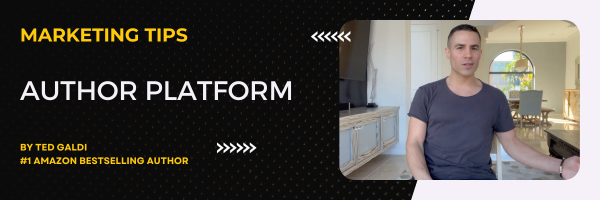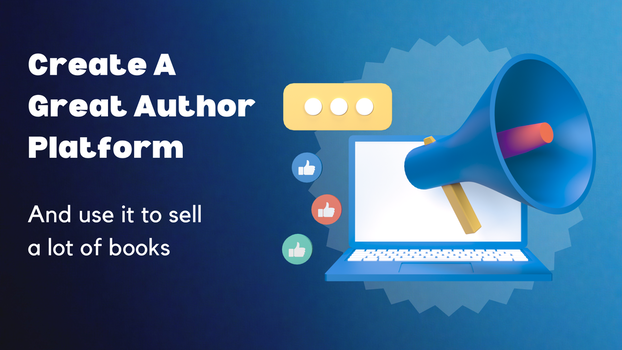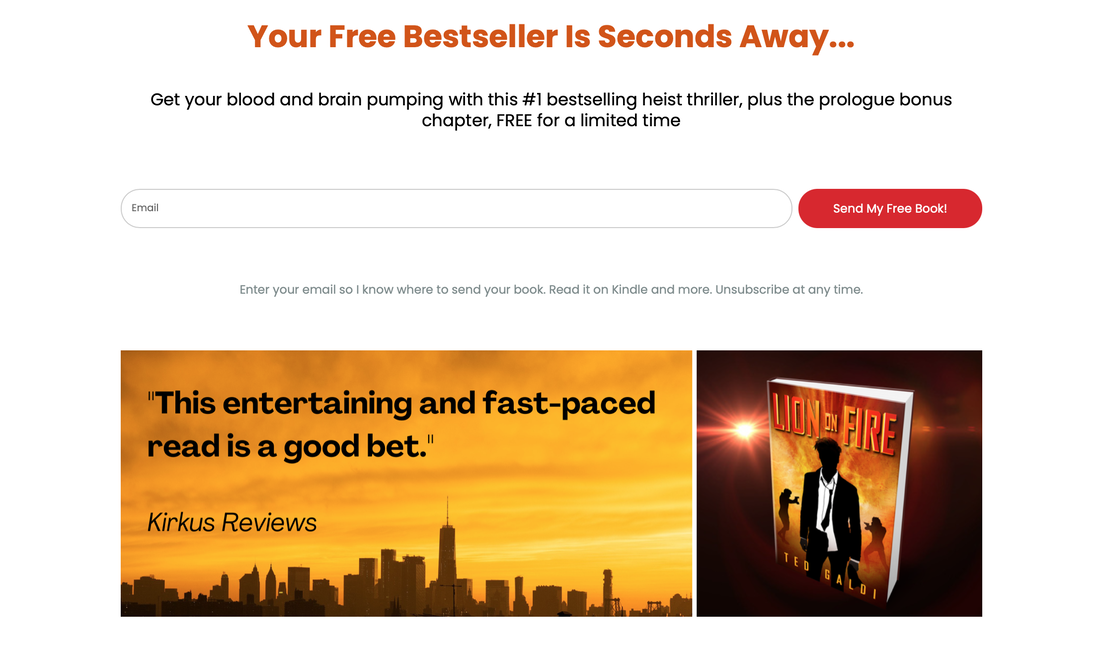How to Build a Great Author Platform [And Sell a Lot of Books]Are you a writer hoping to sell more books? In today's world of digital marketing, learning how to build an author platform involves knowledge of various online tools. Fortunately, I will guide you through the steps to a great author platform, even if you don't have any technical skills. Download my FREE guide for marketing a bestseller Author platform meaningAn author platform is a combination of tools a writer uses to promote a book, whether fiction or non-fiction. Typically, these tools include a personal website, social media profiles, and an email list. Author platform tips - with examplesI'm going to provide tips for the three major pieces of an author platform, using my own for examples. 1 - Author websiteThis is the home page of the website you're on. Though I post articles on this site intended for other writers (like this one), the home page - and many other pages - are intended for readers, ie people interested in my books. A writer website is important because it gives you a place to promote any book or online offer you have. As the call to action of any marketing campaign, you can direct people to a page on your website to download something, buy something, read a preview of something, etc. I use my site to do the following:
Do you need an author website? You can easily create one via an online template, even if you don't know anything about web design or computer programming. Check out my guide for building one. If you don't want to spend time building your own site, no problem. My author-service company, Galdi Media, can create one for you. What if you don't have a book out yet? Even if you haven't yet released a book, if you're planning to in the future, you should create a writer website now. Why? Firstly, you want to secure the domain for your name (ie, yourname.com) before someone with the same name as you does. Also, once you have a website, you can start building an audience and drumming up anticipation for your upcoming book, well before it's released. Click the link above, to my guide, to secure your domain and get your site live today. Adding a reader magnet to your author websiteA reader magnet is a digital item, usually a PDF (or ePub), that would be of interest to people who read books in your genre. If you write fiction, this might be a short story. If you write non-fiction, this might be a checklist that helps people develop an important skill in your field. Some writers offer a full book as a reader magnet. However, this in no is way the only viable path. A reader magnet does not need to be a long document that takes you months to create. Some of them are just a single page. Here are some more ideas... Reader magnet ideas for fiction writers
Reader magnet ideas for non-fiction writers
Use software to deliver your reader magnetAn author offers a reader magnet as a way to entice relevant readers to join an email list. To get the digital item, people need to give the author their email address. A download link for the item is then sent to them (and they become subscribed to the author's list). Fortunately, you don't have to manage all these email addresses and deliver all these links manually. An email marketing system can handle all that for you. Want to become a bestselling author?
2 - Author email listHaving an email list is crucial. Though social media platforms (more on them next) are very effective marketing tools, sometimes their algorithms may only show your posts to a fraction of your followers. However, with email, you have a direct line of communication to your subscribers. An email you send will get delivered to everyone on your list. For a new book, when you want to drive a lot of sales on release day, sending an email to your list is a dependable, powerful tactic. Do you have an email marketing software yet? If not, I suggest you sign up for one today. Many have a free plan for those just starting out. I use a system called MailerLite, which has a great reputation among authors. To learn more about it and get a free account, check out this email marketing article. If you're using a system other than MailerLite, I suggest you compare their pricing and see if switching can save you money (it probably can). Not only is MailerLite free for up to 1,000 subscribers, but once your list grows, the monthly cost is very affordable. To learn more about pricing at various volume levels, click the link to the email marketing article above. How to set up an email marketing systemYou need to do two simple things inside your email marketing system to get started (and manage your reader magnet): (1) Set up a landing page (2) Set up an automated welcome email Building a landing page for your reader magnet MailerLite and other services provide attention-grabbing, easily customizable templates you can use for these landing pages. On yours, write some promotional copy to convince people to download your reader magnet. Also, try to include at least one relevant graphic, ex, a cover for a short story, or the first few steps of a checklist. If you need help making graphics, I recommend a free app called Canva. Once you have your landing page, you want to prominently include the link to it on the home page of your author website. You can use a tool like Hello Bar to bring even more attention to your link. Here's my reader magnet landing page, which you can get to in just one click from my home page: Sending a welcome message to deliver your reader magnet The automated welcome email is a message you'll write within your email marketing system. The moment people sign up for your email list (ex, when submitting their email address on your landing page), the system will automatically send them this pre-written message. Within it, you'll include a link to download your reader magnet. As mentioned, reader magnets tend to be PDFs (or ePubs). You need to upload your file to the cloud, and get a download link for it. For cloud storage, I recommend Google Drive, which is free. If you have a gmail email address, you already have a Google Drive account. To use it for your reader magnet, just follow these simple steps:
What kinds of emails should an author send?Enabling an automated welcome message is just the beginning. You can use your email software to accomplish a lot more. It should be the facilitator of long-term, two-way communication between you and your audience. Each email you send should have a specific purpose, centered around some sort of value you're delivering to your subscribers. Some popular purposes for author emails:
When should an author send emails?A good email marketing software will offer the option to send an email as part of an automation sequence or as a broadcast. An automation sequence contains various emails that are pre-written by you and delivered based on certain triggers. The welcome message is an example. You can create others and have them sent when certain conditioners are met. A simple, popular trigger is time. Ex, you can have your email provider send a certain message X days after a subscriber joins your list. The next automated message might go out in X + 7 days, then X + 14, etc. A broadcast email is a message that's delivered to your entire list (or a custom portion of it, if you'd like) at the same time. Here's how I send my emails:
If you want help organizing your different ideas for emails, I recommend the task management app Todoist, which has a free version. 3 - Author social mediaIn general, social media apps serve two major purposes for an author:
Many social media apps exist, however, audience interests on each don't exactly overlap. A post may perform well on one while hardly getting noticed on others. Frequently posting unique content on many apps can be quite time-consuming. I suggest you make accounts on as many networks as you'd like, but focus on just 1-3 of them. I find Facebook is a great app for connecting with my existing readers, while TikTok is very helpful with showing my books to new readers, particularly because of its wide-reach BookTok hashtag. My profiles on these two networks: These two apps have worked well for me, however, you may find others are a better fit for you. As mentioned, I write fiction, but also put out articles (and videos) for other writers. Though I use Facebook and TikTok pretty often for my fiction books, I don't use them nearly as much to share my content for writers. YouTube and Pinterest, which function as search engines, are better suited for educational content. When you create social media profiles, include a link to your website on them, along with some brief text encouraging people to visit the site so they can download your free reader magnet. Here's a list of social media sites that are popular with authors:
Also, I recommend any author create a profile on Goodreads, a review site run by Amazon. Technically, it's a social network, however, unlike the ones listed above, its marketing benefits for authors don't require frequent posting. Rather, it's a forum for readers to share reviews about your books, intended for other readers. It doesn't require much time from you, while carrying the potential to drive a lot of positive word of mouth advertising. What should authors post on social media, and how frequently?What you post on social media depends on the apps you choose to focus on, what sort of content readers in your genre are looking for, and what type of content you like making. I suggest you visit various sites, search for keywords related to your genre, and see the kinds of author accounts that are generating a lot of activity. What sort of content are those authors posting? How could you create posts of the same type, but with your own take? Whatever the specifics, your posts should have a purpose. In general, the subjects of author social media posts are the same as the ones of author emails:
I also suggest you create at least a couple posts a month encouraging people to click the link in your profile to download your reader magnet. Most networks tend to favor accounts that post regularly, ie, once a day or at least once a week. Feel free to start with just one app, posting once a week, to get comfortable. Over time, you can up the networks and frequency. To save time, a software I recommend is Tailwind, built for social media management. It can help you choose effective post ideas, design the posts, and schedule them. More author platform elementsThough a website, email list, and social media accounts tend to form the basis of an author platform, other elements can surely be included. A podcast is a popular digital tool that many authors, especially in non-fiction genres, use. Article sites, like Medium, are also used widely in the non-fiction sphere. Paid author adsAnother impactful way to bring attention to your books is paid ads. Building an email list and social media following, though beneficial, can take months. However, paid ads can work right away. If you have a new book coming out, and don't have a large audience on email or social media yet, you might want to consider paid ads. Even if you do have a large audience, paid ads can be an effective traffic source alongside emails and social media posts. The importance of marketing for authorsIf you are a traditionally published author, your publishing company can market your book for you. However, if you have a great author platform, you can market the book alongside your publisher's campaign, increasing the effectiveness of the book's promotion. Maybe you aren't a traditionally published author, but would like to be. If so, the size of your email list and social-media followings can help get you a deal. Publishers often like to partner with authors who can contribute to a book's marketing success. If you're a self-published author, and don't want to go the traditional route, developing a great author platform is critical. If you work with a self-publishing company, they can run ads for you, however, to increase your chance of becoming a bestseller, you should have a strong author platform to promote your book, too. Possibly you don't work with a self-publishing company, or any marketing freelancers, and instead handle all of your promotion on your own. If so, the reach of your author platform is crucial, as is your effectiveness at running paid ads.
0 Comments
Leave a Reply. |









 RSS Feed
RSS Feed